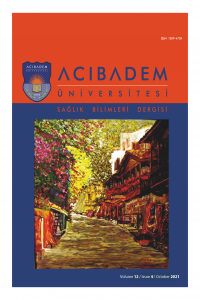Abstract
References
- 1. Schaftenaar E, Bastiaens GJH, Simon ENM, Merkx MAW. Presentation and management of maxillofacial trauma in Dar Es Salaam, Tanzania. East Afr Med J. 2009;86(6):254–8. 2. Park K-P, Lim S-U, Kim J-H, Chun W-B, Shin D-W, et al. Fracture patterns in the maxillofacial region: a four-year retrospective study. J Korean Assoc Oral Maxillofac Surg. 2015;41(6):306. 3. Püsküllüoğlu S, Acikalin AY, Mehmet AY, Kozaci N, Akkan AV, et al. Analysis of adult trauma patients admitted to emergency department. Cukurova Medical Journal 2015; 40: 569-79.
Abstract
Purpose: In this study, it was aimed to examine the characteristics, causes of trauma, and age distribution of maxillofacial fractures in patients admitted to the emergency department as a result of blunt maxillofacial trauma.
Patients and Methods: Between 01.01.2015-31.12.2019, 1248 patients who were admitted to the emergency department with maxillofacial trauma were evaluated retrospectively. Patients who underwent CT examination and were diagnosed with fracture were included in our study.
Results: The median age of the patients was 32 years, and 71.2 % of them were male. Trauma-related fractures were detected in 239 (19.2%) of 1248 patients with maxillofacial trauma. The affected group of participants comprised of individuals of younger age and male gender. The main mechanisms of trauma were traffic accidents and falls from height. Orbital fractures were the most common, followed by maxillary bone fractures. Severe maxillofacial fractures were often accompanied by traumatic brain injuries. The mortality rate was low (0.4%) in patients with isolated maxillofacial trauma compared to patients with polytrauma (16%) ( p= 0.001). In our study, it has been shown that face AIS (Odds ratio: 2.79) and Glasgow coma score (Odds ratio: 0.98) can predict mortality in trauma patients with multivariable regression analysis.
Conclusion: As a result of this study, we determined the relationship between variables associated with common traumatic injury in the maxillofacial region. Age, gender, and injury mechanism are of great clinical importance in the identification and prediction of traumatic maxillofacial fractures.
References
- 1. Schaftenaar E, Bastiaens GJH, Simon ENM, Merkx MAW. Presentation and management of maxillofacial trauma in Dar Es Salaam, Tanzania. East Afr Med J. 2009;86(6):254–8. 2. Park K-P, Lim S-U, Kim J-H, Chun W-B, Shin D-W, et al. Fracture patterns in the maxillofacial region: a four-year retrospective study. J Korean Assoc Oral Maxillofac Surg. 2015;41(6):306. 3. Püsküllüoğlu S, Acikalin AY, Mehmet AY, Kozaci N, Akkan AV, et al. Analysis of adult trauma patients admitted to emergency department. Cukurova Medical Journal 2015; 40: 569-79.
Details
| Primary Language | English |
|---|---|
| Subjects | Emergency Medicine, Radiology and Organ Imaging |
| Journal Section | Research Article |
| Authors | |
| Publication Date | September 29, 2021 |
| Submission Date | March 15, 2021 |
| Published in Issue | Year 2021 Volume: 12 Issue: 4 |

